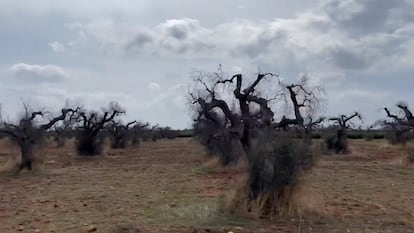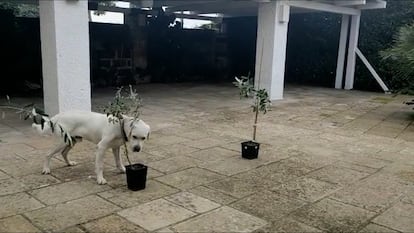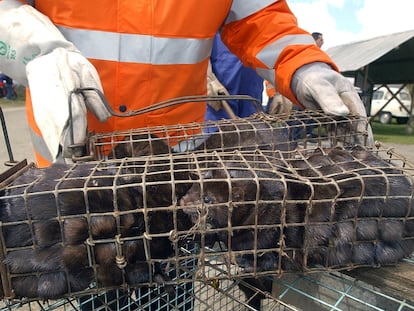Army of scientists battles bacteria that has annihilated millions of olive trees
Agricultural engineer Blanca Landa heads an international project to stop the spread of ‘Xylella fastidiosa’, a microbe that is threatening the Mediterranean agricultural sector
Blanca Landa still recalls with horror the day she first came face-to-face with the plague. It was 2014 and the plant pathologist was touring the olive groves of Apulia, a region that forms the heel of Italy’s “boot.” “It’s like a disaster movie where a bomb has been dropped and everything has dried up. Driving by car, you see miles and miles of dry trees. Thousands and thousands of hectares. It is an ecological disaster.”
Landa uses the present tense because since she first encountered it the plague, caused by the Xylella fastidiosa bacterium, has spread like wildfire to Spain, France and Portugal. It is one of the greatest overall threats to world agriculture, but also to the immemorial landscapes in which generations have grown up in villages across southern Europe. Landa has just taken the reins of an international project to try to halt the advance of the microbe, which when it reaches a new region turns it into a kind of plant-based Chernobyl.
Xylella, which originated in the Americas, measures little more than one thousandth of a millimeter. The bacterium multiplies in the sap-conducting vessels of a tree and can clog them, suffocating the branches. Insects of the Cicadellidae family, known as leafhoppers, are responsible for transporting the microbe from one plant to another. The main hypothesis is that the microorganism arrived in southern Italy in 2008, transported on ornamental coffee plants from Costa Rica. By the time it was detected in 2013, it was already too late. Within a few years, the bacterium had wiped out more than six million trees. Landa recalls scenes of elderly farmers weeping, hugging their diseased centuries-old olive trees. The main strategy against the bacterium is to uproot the infected tree, and all others within 50 meters of it.
Landa opens a small refrigerator in one of her laboratories at the Institute of Sustainable Agriculture (CSIC) in Córdoba, Spain. It contains samples of almost a hundred different strains of the bacterium, stored at -80ºC (-112º F). “This is the largest collection of Xylella in Europe,” she explains. The list of microbes in the freezer is hair-raising: they come from vines in California, cherry trees in Mallorca, broom in Corsica, coffee plants in Mexico, elm trees in Washington DC, almond trees in Alicante, and olive trees in the Balearic Islands and Apulia. Xylella is capable of infecting up to 600 different plant species, often without causing symptoms. It travels the world without arousing suspicion and attacks the main species that characterize the Mediterranean agricultural landscape: olive trees, vines, almond, citrus and stone fruit trees.
In Spain, the microbe was first detected in October 2016, in three cherry trees at a garden center in Mallorca, but Landa believes that the pathogen had entered the Balearic Islands much earlier, around 1994, in almond trees introduced from California. The regional government of the Balearics ordered thousands of trees to be uprooted in 2016, before surrendering to the evidence that it was already impossible to eradicate the bacterium in the Mediterranean archipelago. The other major focal point is in the province of Alicante, on Spain’s eastern coast, where an out-of-control epidemic is ravaging agriculture despite the uprooting of almost 190,000 almond trees since 2017. Olive growers on the peninsula are fearful: There are more than 300 million olive trees in Spain, which produce around half of the world’s olive oil.
So far the microbe is winning the war. “You have to learn to live with the bacteria and minimize the damage. What growers would like – to throw a pesticide at it and for the problem to simply disappear - will never happen,” says Landa, who was recently appointed president of the Spanish Society of Phytopathology. The international project she oversees, which has received €7 million of European Union funding, is largely focused on developing methods to detect the microbe. “The best way to combat the bacteria is to keep it out,” she says. Landa coordinates the work of some 30 institutions from 14 countries. Three Italian organizations are training dogs to sniff out the bacteria at border ports, even on infected plants that are showing no symptoms. Spanish researcher Pablo Zarco and his team at the University of Melbourne is perfecting a system to identify affected trees by means of special cameras placed on airplanes.
Landa and her group work in the largest high-security greenhouse in Spain, recently inaugurated in Córdoba. To reach its 400 olive seedlings, you have to pass through three doors with three different codes, including the scientists’ fingerprints. A negative pressure system prevents air from escaping the enclosure. All waste is treated with soda and hydrochloric acid before being sent down the drains. It’s a bunker for researching plant pests.
Landa and her team are preparing to infect eight of the most economically important olive varieties with the bacteria. Agricultural engineer Miguel Román walks among the seedlings and recites the varieties from memory: picual, arbequina, hojiblanca, gordal, arbosana, cornicabra, frantoio and a species of wild acebuche. The goal is to test which varieties of olive trees are most resistant to the bacteria and why. “We are going to inoculate the Ibiza strain, because we consider it to be the most at-risk in Spain, and also one from Mallorca,” she explains. This subtype, which is devastating hundred-year-old olive trees in Ibiza, is similar to the variant that has destroyed millions of trees in Apulia.
In southern Italy, Landa says, “the perfect storm” has taken place: a very susceptible variety of olive trees, an extremely virulent strain of the bacterium, a favorable climate and an abundance of leafhoppers due to the local custom of letting grass grow in the olive groves. “The carrier insect populations are enormous; you have to try to keep them out of your head. In Spain, studies have been done on olive trees and their numbers are very low,” she says. However, the microbe is spreading throughout the Iberian Peninsula. In December, Portugal announced the first detection of Xylella fastidiosa in citrus trees within the European Union.
Biologist Pilar Velasco displays her experiments with different strains of the bacteria, conducted in silicone conduits that mimic the vessels in trees. “They become clogged within a week,” she says. In trees, Landa points out, the process is slower and more capricious. “We still don’t know how long it takes. We have inoculated the bacteria in olive plants and it has colonized the whole tree, but in three years it has not killed it nor have we observed symptoms. We still don’t understand very well what triggers the plant to start getting sick.”
Another biologist on the team, Manuel Anguita, has the task of investigating the “more than 2,000 species of bacteria” that live inside an olive tree. He is happy because he has just extracted 13 milliliters of sap from a branch; a considerable amount. The group’s goal is to design a cocktail of beneficial bacteria that can be injected into young seedlings in nurseries, on the basis that the presence of these healthy microbes will prevent the pathogen from gaining a foothold.
Blanca Landa recounts sadly that, on her expeditions to southern Italy and the Balearic Islands, she has felt “centuries of history collapsing” on her shoulders. One of the oldest olive trees in the world, known as the Farga del Arion, is located in the municipality of Ulldecona, in Tarragona, Spain. It was planted by Roman farmers in the year 314 AD, in the time of Emperor Constantine, according to scientific dating. It is over 1,700 years old. What is at stake, Landa insists, is not only the economic survival of agricultural towns and villages, but the collective memory of their people. As the poet Miguel Hernández said in verse: “The orange tree tastes of life and the olive tree tastes of time.”
Sign up for our weekly newsletter to get more English-language news coverage from EL PAÍS USA Edition
Tu suscripción se está usando en otro dispositivo
¿Quieres añadir otro usuario a tu suscripción?
Si continúas leyendo en este dispositivo, no se podrá leer en el otro.
FlechaTu suscripción se está usando en otro dispositivo y solo puedes acceder a EL PAÍS desde un dispositivo a la vez.
Si quieres compartir tu cuenta, cambia tu suscripción a la modalidad Premium, así podrás añadir otro usuario. Cada uno accederá con su propia cuenta de email, lo que os permitirá personalizar vuestra experiencia en EL PAÍS.
¿Tienes una suscripción de empresa? Accede aquí para contratar más cuentas.
En el caso de no saber quién está usando tu cuenta, te recomendamos cambiar tu contraseña aquí.
Si decides continuar compartiendo tu cuenta, este mensaje se mostrará en tu dispositivo y en el de la otra persona que está usando tu cuenta de forma indefinida, afectando a tu experiencia de lectura. Puedes consultar aquí los términos y condiciones de la suscripción digital.
More information
Archived In
Últimas noticias
The murder of Michele and Rob Reiner: A tale of horrific days in Hollywood
Trump orders a ‘complete blockade of sanctioned oil tankers’ going to and from Venezuela
Not all insomnia is the same: Study identifies five subtypes and paves the way for personalized treatment
The United States designates Clan del Golfo as a foreign terrorist group
Most viewed
- ‘El Limones’ and the growing union disguise of Mexican organized crime
- Christian Louboutin: ‘Young people don’t want to be like their parents. And if their parents wear sneakers, they’re going to look for something else’
- ‘We are dying’: Cuba sinks into a health crisis amid medicine shortages and misdiagnosis
- A mountaineer, accused of manslaughter for the death of his partner during a climb: He silenced his phone and refused a helicopter rescue
- The low-cost creative revolution: How technology is making art accessible to everyone













































